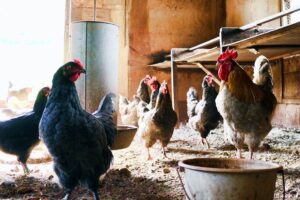Table of Contents
LA 200 for chickens is a popular treatment for Chronic Respiratory Disease (CRD).
A highly contagious infection known as Mycoplasma gallisepticum (which does not harm humans) is believed to cause this disease.
When a chicken gets infected, it passes the bacteria to its eggs and becomes a life-long carrier.

Years ago, chicken keepers would kill infected chicks to prevent the spread of the disease.
However, the LA 200 makes it possible to contain the disease.
Even when your chickens get infected, you can still treat and raise them for meat.
Keep reading to learn more about this special treatment for CRD in chickens.
What is LA 200 for Chicken
The LA 200 for chickens is an antibiotic used in treating respiratory diseases in chickens. It’s also referred to as oxytetracycline.
It’s one of the most effective treatments for CRD in chickens if anyone decides to treat them rather than cull them.
Breeders and chicken keepers wouldn’t keep infected chickens, of course, before the discovery of this treatment.
This antibiotic is typically administered through an injection (IM).
Understand that this is simply treatment and not cure. Your chickens will remain carriers of the diseases.
Therefore, you should not keep sick chickens for sale but only for meat at home.
As mentioned, Mycoplasma gallisepticum isn’t harmful to humans. Chickens with CRD will show many different symptoms, including:
- Eye problems
- Open mouth breathing
- Gurgling throat sounds
- Inflammation around the cere and face.
CRD often comes with wild birds within an area.
That means your chickens will be more susceptible to the disease if you let them on free range.
Or if your fencing allows small wild birds like the goldfinch to come close to your chickens, then they will be at a higher risk of contracting the disease.
You might not cage the chickens all the time, but you should at least ensure your fence is okay.
What is the Correct Dosage for LA 200 for Chickens?
Knowing the correct dosage for LA 200 for chickens is essential for your chickens’ treatment.
The true dosage will effectively treat gurgling, gasping, and other CRD symptoms we have mentioned above.
Use 0.2 cc in a pound (5lb chicken takes 1 cc). Inject this antibiotic once into the breast about 1/4-inch deep.
Inject another dose after 3 days – LA 200 is a broad spectrum and mostly doesn’t begin dissipating until day 3.
From day one to day three, rub VetRx onto the chickens’ nostrils and combs.
Add an ounce of VetRx to a gallon of water for their water.
This water must be faucet hot first to facilitate mixing with the water.
Give another dose of the LA 200 for chickens on day three – don’t exceed the dosage above.
On days three through six, apply the VetRx as explained above both in their water supply and topically.
During this time, put a heat lamp on the chickens and keep them from the wind.
In other words, you should keep the chickens warm and healthy after receiving the treatment.
By day seven, your chickens should look healthy.
Ensure you follow this dosage precisely, and your chickens will get well too.
How long will it take to see improvement?
Your chickens will begin to show noticeable improvement in 24 to 72 hours.
As mentioned, LA 200 for chickens is very effective at combating the symptoms of CRD.
However, you have to give them the correct dosage as described above.
If you can’t handle it yourself, we recommend you call a reliable veterinarian to help with the treatment.
Can LA 200 Also Be Given Orally?
The LA 200 for chickens is normally administered through an IM. However, it can also be given orally in feed and drinking water.
Indeed, there’s usually a risk of it causing necrosis or irritation.
After an injection, peak levels may take effect in 30 minutes to a few hours, depending on the injection spot and volume.
When administered orally, LA 200 is readily absorbed in fasting birds.
Bio-availabilities are about 60% to 80%.
The presence of foods or products containing minerals such as Calcium (Ca), Magnesium (Mg), and Iron (Fe) alter or reduce the absorption rate of the drug.
If put in drinking water, LA 200 should be given in feed as well – simultaneously.
Are there any LA 200 Side-Effects on Chickens?
LA 200 for chickens may cause mild to serious side effects.
As mentioned, if you administered it through IM, it can cause necrosis at the injection spot.
Another common side effect is the disruption of normal gut flora.
That means your chickens are more susceptible to infection with other pathogens.
Additionally, the treatment may impact egg production and quality.

LA-200 for Chickens – Egg Withdrawal
As we mentioned, your chicks will carry CRD for life.
It’s sad, and although not harmful to humans, it’s discouraged to breed from your infected flock and sell to other people. Only breed to eat at home.
Eating the chickens is only recommended after completing the treatment.
Avoid indulging during the treatment. As the name suggests, the disease is chronic.
That means the symptoms will disappear but then come back unexpectedly.
The disease may also move from the mother chicken to the offspring – through the egg and the developing embryo. For makes chicks that hatch infected with the disease.
LA 200 for Chickens Alternatives
The most popular alternative for LA 200 for chickens is the VetRx – although mostly used together (explained above on LA 200 dosage).
VetRx is a 100% natural remedy for numerous chicken issues and is popular among millions of keepers.
It’s formulated to help in the following ways:
- Treat respiratory illness, colds, eye worms, and scaly legs.
- This treatment is user-friendly as the liquid form can easily dissolve in warm water making it easy to administer to chickens.
- You can use it to relieve most symptoms of sick birds and poultry
- VetRx is sometimes used to improve the condition and performance of show birds.
- It can also be effective in controlling parasites and diseases.
- It’s an excellent tonic to boost the broodstock fertility and production.
Other popular LA 200 for chicken alternatives that can help manage the symptoms of CRD include:
- Tylosin – very effective antibiotic and popular among vets.
- Chlortetracycline – commonly used for egg layers
- Enrofloxacin – off-label use
- Doxycycline – is a common antibiotic used by chicken keepers throughout the world. It’s not registered for egg layers.
- Lincomycin with Spectinomycin – the most popular treatment for chickens with CRD – doesn’t have a withholding period for eggs.
Note
We recommend you consult your vet anytime you want to use these treatments. The vet will advise you on the most effective option for the particular illness your chicken may have.
Conclusion
The above was our guide on LA 200 for chickens.
We have learned that it’s a broad-spectrum antibiotic used for treating CRD.
This disease doesn’t affect humans. It’s not curable, and only its symptoms, which include eye problems, and gurgling throat sounds, can be treated.
LA 200 may cause mild to serious side effects.
The treatment is often administered through an injection, but it’s more effective and causes few side effects if administered orally.
VetRx is one of the most popular LA 200 alternatives.
We hope you found this guide helpful and that you have found all the information you needed.









